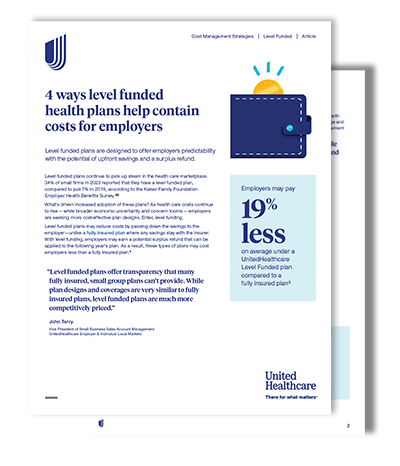4 ways level funded health plans help contain costs for employers
Level funded plans are designed to offer employers predictability with the potential of upfront savings and a surplus refund.
Level funded plans continue to pick up steam in the health care marketplace. Thirty-four percent of small firms in 2023 reported that they have a level funded plan,1 compared to just 7% in 2019, according to the Kaiser Family Foundation Employer Health Benefits Survey.2
What’s driven increased adoption of these plans? As health care costs continue to rise, while broader economic uncertainty and concern looms, employers are seeking more cost-effective plan designs.
Level funded plans may reduce costs by passing down the savings to the employer — unlike a fully insured plan where any savings stay with the insurer. With level funding, employers may earn a potential surplus refund that can be applied to the following year’s plan. As a result, these types of plans may cost employers less than a fully insured plan. In fact, employers may pay 19% less on average under a UnitedHealthcare Level Funded plan compared to a fully insured plan.3
Level Funded Group health plans
“Level funded plans offer transparency that many fully insured, small group plans can’t provide. While plan designs and coverages are very similar to fully insured plans, level funded plans are much more competitively priced.”
Understanding level funded plans
While there’s been increased adoption, understanding the value of level funded plans still requires some education in the market.
At their core, level funded plans are generally self-funded plans that offer 3 distinct elements, with certain plan components variable among carriers:
- Stop loss insurance to help mitigate claims risk
- An opportunity for a surplus refund4
- A third-party claims administration agreement
Level funded plans also can include monthly reports with data that employers can use to track health care usage and wellness programs that may increase member engagement and reduce costs.
To take a closer look at how level funded health plans help contain costs for employers, here’s how they compare to self-funded and fully insured plans:
1. Level funded plans offer predictability and mitigate the risks of self-funded plans
Similar to a self-funded plan, level funding allows employers to assume the financial risk of providing health services to employees by directly paying for employee medical claims.
How do these plans mitigate risk? Employers with level funded plans pay a fixed monthly fee, which covers the maximum claims liability, administrative fees and stop loss insurance to protect against unexpectedly large claims and high utilization.
In a self-funded model, the employer pays more if claims are higher than anticipated and gets money back if claims are lower at the end of the plan year. Level funded plans, however, cover the cost of individual or aggregate claims that exceed the plan’s maximum, while offering the health plan an opportunity to receive money back if lower-than-expected claims produce a surplus.
“Level funded plans mitigate risk associated with the self-funded model," Koewler says. "There is no risk of additional liability outside of what is being funded.”
2. The plan sponsor may receive a surplus refund with level funded plans
For a fully insured plan, the insurance company assumes the financial risk for providing health services to the employer group. For a fixed cost paid by the employer, the insurer pays health care claims and covers administrative costs, sales commissions and taxes. At the end of the plan year, if the actual health care claims are higher than expected, the insurer pays them. The insurer keeps the difference if they’re lower.
In contrast, an employer with a level funded plan is insured against higher-than-expected claims while potentially receiving a surplus refund resulting from lower-thanexpected claims.
3. Level funded plans offer greater insights to help contain costs
Unlike with most fully insured plans, employers with level funding can receive detailed monthly data reports to help them better understand employee utilization of health services and manage their benefits.
“With our monthly reporting package, employers are able to see how their group is running and can see trends and utilization within their specific population. The report contains a lot of impactful and useful information,” Koewler says. “They don’t have to wait until the renewal period at the end of the year before they can understand how member behavior may be driving up costs.”
These insights may enable employers to alert individual members that:
- Low-cost generic medications can often be substituted for brand name medications
- Going to urgent care may be more appropriate and less costly than going to the emergency room
- Seeing their primary care provider virtually rather than in-person can save them time and money
“Detailed data reports are a huge advantage, especially for small employers, by giving them insights into their virtual care usage, ER use, pharmacy utilization and network strategy,” Koewler says. “Tracking these things over time and making informed decisions as needed can help drive a better member experience.”
4. Member experience is key within the level funded model
UnitedHealthcare Level Funded plans include wellness programs and 24/7 virtual care options, which may help employees and their families play a more active role in their health care and save on out-of-pocket costs.
Employees in some markets may be invited to participate in UnitedHealthcare Rewards, where they can earn up to $1,000 for completing healthy activities. To offer employees more convenience, 24/7 virtual care is available for a variety of conditions, including general medical care and behavioral health counseling.
“The member experience including virtual, health engagement and plan design options is what distinguishes our level funded plan,” Koewler says. “It helps to increase customer satisfaction and engagement for employees; for employers, it’s the opportunity for lower costs and the chance to achieve a surplus refund.”
